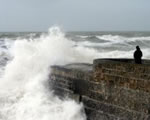 Go to main content
Go to main content
Archive Website of the UK government
Please note that this website has a UK government accesskeys system.
Main menu
Page menu
Environment and greener living

Effects of climate change

The effects of climate change can be seen in the UK and around the world. UK temperatures, including those of British coastal waters, have already risen. Globally, extreme weather is predicted to become more common and to have a negative impact on humans, animals and plants.
Rising temperatures
Globally, 2000 to 2009 was the warmest decade since records began in 1850. The average temperature of the atmosphere near the Earth’s surface has risen by about 0.75 degrees Celsius since around 1900.
The overwhelming view amongst climate science experts is that, if we continue to emit greenhouse gases:
- global temperatures could rise between 1.1 and 6.4 degrees above 1980 to 1999 levels
- this could happen by the end of the 21st century
The exact amount depends on the levels of future greenhouse gas emissions.
Changing sea levels and temperatures

The sea level around the UK has risen
UK coastal waters have warmed by about 0.7 degrees Celsius over the past three decades. In addition, the average sea level around the UK is now about 10 centimetres higher than it was in 1900.
Globally, the average sea level could rise by 18 to 59 centimetres, or more, by the end of the century. Rising sea levels could swamp some small, low-lying island states and put millions of people living in low-lying areas at greater risk of flooding.
You can use Google Earth to see how climate change could affect temperatures and ice caps over the next century. Google Earth also lets you view the loss of Antarctic ice shelves over the last 70 years.
Extreme weather
Since rain records began in 1766, the amount of winter rainfall in England and Wales has risen slightly. However, over the last 45 years there is evidence that there have been more extreme rainfall events. UK flooding was the worst for 270 years in some areas and in 2009, some areas, like Cumbria, witnessed widespread flooding. Flood damage now costs Britain about £1 billion a year.
Globally, continuing warming means that extreme weather events – like severe floods, droughts and tropical storms – are likely to become more frequent and dangerous. Such extreme weather events are likely to become more severe during in coming decades.
Plants and animals

A global temperature rise could make some species extinct
There are already changes to the way plants and animals live in this country. The period between spring and autumn when plants grow is now about a month longer in central England than it was in around 1900.
Further changes in rainfall and temperature will affect many animal and plant species around the world. Some species might be unable to adapt quickly enough and habitats might not be available for them to move into. If global temperatures rise by two degrees Celsius, 30 per cent of all land-living species could be threatened by an increased risk of extinction.
The cost of climate change
The Association of British Insurers estimates that UK households will pay up to four per cent extra each year due to extreme weather events.
The costs of climate change are expected to be huge, as the Stern Report on the economics of climate change made clear. The report estimated that not taking action could cost from five to 20 per cent of global Gross Domestic Product (GDP) every year. In comparison, reducing emissions to avoid the worst impacts of climate change could cost around one per cent of global GDP each year.
Food and water
As temperatures increase and rainfall patterns change, crop yields are expected to drop significantly in Africa, the Middle East and India.
Water availability for irrigation and drinking will be less predictable because rain will be more variable. It is also possible that salt from rising sea levels may contaminate underground fresh water supplies in coastal areas. Droughts are likely to be more frequent. Up to three billion people could suffer increased water shortages by 2080.
Disease
With rising temperatures, diseases like malaria, West Nile disease, dengue fever and river blindness may shift to different areas. It is predicted that 290 million additional people could be exposed to malaria by the 2080s. The UK Climate Impacts Programme (UKCIP) says that health of people in the UK will also be affected.
Rainforests
Large areas of the Amazon and central African rainforests could be lost if climate change results in big decreases in rainfall in these areas. This would be on top of the forest already being cut down to clear land for agriculture. These forests currently absorb large amounts of carbon dioxide that would otherwise be released into the atmosphere.
What you can do
There are challenges ahead, but progress is being made. Actions by individuals have already helped the UK meet its targets for cutting emissions by 2010. You can help influence future effects of climate change, often with quick and easy actions like changing your lightbulbs or turning your appliances off standby.
 Facebook
Facebook Twitter
Twitter StumbleUpon
StumbleUpon Delicious
Delicious Reddit
Reddit
